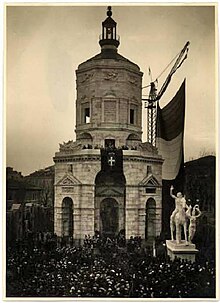
The Tempio della Vittoria or Temple of the Victory, also called the Shrine of the Fallen (Soldiers) of Milan is a monumental chapel building located on largo Agostino Gemelli, just north of the Basilica of Sant'Ambrogio and southwest of the Università Cattolica del Sacro Cuore in Milan, region of Lombardy, Italy.
History and description
After, the World War I, this monument was commissioned by the Associazioni Combattentistiche to honor the soldiers from Milan who had died in that war. The selection process was mildly complicated: the first proposals were for a monument without a shrine or cemetery that had been planned to be placed in front of the train station. But a second plan was instead selected, through a more limited request of proposals, to use this site near Sant'Ambrogio which had been a previously associated with a cemetery of early Christian martyrs.
The project was mainly designed by the architect Giovanni Muzio with collaborations with Alberto Alpago Novello, Tomaso Buzzi, Ottavio Cabiati, and Gio Ponti. The work began in 1927, and the shrine was inaugurated on 4 November 1928, on the tenth anniversary of the Victory in World War I. The ceremony was led by the Prince Emanuele Filiberto, Duke of Aosta, former commander of the 3rd army in that war and named in 1926, marshal of Italy.

The while marble shrine is an octagon, that some described as a tower ringed with eight triumphal arches. The octagon had been used often in Italy as a layout for shrines and baptistries, as opposed to the more linear basilica layout for sacramental churches.
The arches of the octagon are meant to represent the eight former gates of the Milan, through which soldiers exited the town. the Four main sides have reliefs depicting the main battles by the army, in each a stone ur holds earth from these battlefields. The stone entrance wall to the shrine is flanked by two fasces.
Inside the shrine, it was planned to place a secular bronze sculptural group of a horseman led by an allegorical Victory, both naked, by Libero Andreotti titled as the Return after the Victory; the stucco model of the statue was once outside the temple, but the bronze counterpart was never completed. While the sober architectural modelling of the shrine was praised, this sculptural group met much criticism: Orsini of the Sera newspaper commented: that "the horse distances itself, to its detriment, from the well-known classical patterns. The adjacent female victory would fall, despite its wings: it doesn't grab the bridle."
Outside of the shrine at the entrance, facing the entrance gates is a four meter tall bronze statue depicting St Ambrose tramples on the seven sins(1928) by Adolfo Wildt. The seven sins are allegorized by mice below his left foot.
The shrine was heavily damaged by the 1943 Allied bombardment. It was restored, and in 1973, three subterranean floors, containing an ossuary, were added under the direction of Mario Baccini with bronze plaques reading the names of ten thousand soldiers and patriots who died in the prior two World wars.
References
- Milano e Provincia, Touring Club Italiano. ed.2003, autori vari.
- Il Tempio della Vittoria e il Pantheon dei Caduti Milanesi, article for La festa rivista settimanale illustrata della famiglia italiana (1927), page 979-980.
- La stampella periodico mensile della sezione milanese, 1928, pages 26-27.
- Visit Milano (ed.), Tempio della Vittoria, Province of Milan, archived from the original on 2014-09-12, retrieved 12 September 2014
Further reading
- A Milano il duca d'Aosta inaugura il Tempio della Vittoria, Istituto Luce, archived from the original on 11 September 2014, retrieved 11 September 2014
- "Monumento ai Caduti", Ordine degli Architetti P.P.C. della Provincia di Milano, archived from the original on 12 September 2014, retrieved 12 September 2014
45°27′48″N 9°10′32″E / 45.46325°N 9.17563°E / 45.46325; 9.17563
Categories: